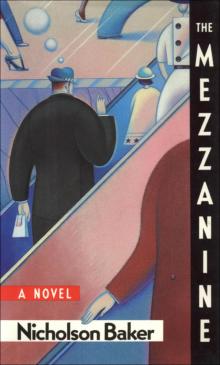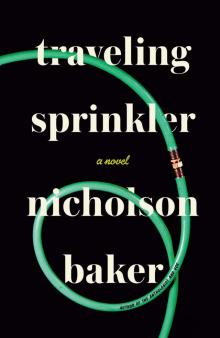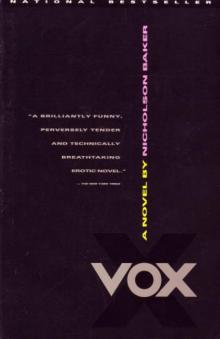- Home
- Nicholson Baker
Mezzanine Page 6
Mezzanine Read online
Page 6
“He came in last week,” said the escalator man, “and I told him, ‘You’re nuts, stay home, all that bending you have to do?’ You could see he was hurting. He was holding onto things.”
“Awful.”
Then, surprisingly, the man shrugged. “He’ll be fine. This happened to him once before. It’s not serious in my opinion.”
“You know Tina, the secretary Tina?” I said, pointing up at the mezzanine.
“I know Tina.”
“Tina has made a get-well poster for him, kind of cornball, with flowers, but really nice, a big poster—it’s up there if you want to sign it.”
“Maybe I’ll get up there this afternoon.” He lifted the rag that had been pressed to the handrail and looked at its underside. The edges of the random folds were already darkened where they had been in contact with the rubber. He bunched the rag a different way, sprayed it with more polish, and reapplied it. “Definitely I’ll sign it. We’ve got to get Ray healthy so I don’t have to run around doing his work.”
“Ray was fast,” I said.
“He is fast. You have to respect his speed. They’ve got a kid in to help out but he’s no good.”
We told each other to take it easy. Then I took hold of the handrail that he had not been polishing (it would have been odd to grasp the handrail he had been polishing—like walking on a newly mopped floor: it would have heightened the always nearby sense of the futility of building maintenance—better to wait until the man had finished the whole handrail before I contributed to the inevitable dulling process that would force him to polish it all over again next week), and I stepped onto the escalator. Without having to look down, I was able to time the moment I took the step that put me in contact with the moving grooves of the escalator so that my foot landed not on a crack between two steps, but on the middle of one of them; and even though just about everyone my age has mastered this skill, I still felt proud of myself, just as I had felt proud of being able to tie my shoes without looking. I also knew by habit just how high the still half-formed and growing escalator step would be as my other foot landed on it, in part gauging the speed of the escalator from the feel of the handrail in my hand. One of the things my mother taught me when I was very little (her emphasis on safety due probably to the fact that escalators and unmanned elevators were still somewhat novel then, and therefore were thought to be, like CRT screens and microwave ovens later, full of new dangers) was always to be sure to retie my sneakers before I used any system of vertical transport. The loose shoelace, I was told, could become caught in the crack between two steps, and I imagined the results: the steps begin to flatten themselves for their Trophonian redescent, hauling Struwwelpeter with them, threshing him, shoe, leg, torso, and finally head, through the metal tines at the top of the circuit, and then steamrolling him still further in the hard-to-picture flat journey in the underside of the stairs. (This was long before I had seen escalators taken apart for repairs, as we often see now in subways, where they break down much more frequently than in corporate settings—is it the heat, or bad maintenance schedules, or the amount of water and dirt and chewing gum they have to handle?—and the triangular shape of the steps finally became clear: before that, the subsiding of what I believed to be a rectangular block into a two-dimensional surface at the end, like the folding up of a travel alarm clock, seemed impossibly complicated.) In high school, I used to ride escalators with my shoes left deliberately untied, in order to demonstrate to myself how safe escalators were, how casually they could be treated1—this was during a phase in which I allowed my shoes to come untied and didn’t bother to retie them, or even slipped them on in the morning untied, as if they were loafers. There were a few years there when lots of undergraduates walked around with laces untended to—1977 or so, simultaneous with Dr. Scholl’s sandals, I think. I had appropriated the practice, thinking it was cool, but my mother, who happened to be taking some classes at the time at the University of Rochester, found it affected and irritating and thought I should stop; and now I can certainly understand how the sight of groups of nineteen-year-olds shuffling around from class to class with the plastic tips of untied Wallabees and Sears work boots clicking against hallway tile, their socked heels occasionally popping right up out of their footwear, would make you shut your eyes for a second at the mindless monkey-doism of the young. Another thing I did even into adulthood was to retie my shoes on the escalator—making it a little challenge: How late in the ride could I successfully tie both shoes without seeming rushed before I arrived at the top?
Given all of these powerful, preexisting connections in my past life between escalators and shoelaces, you would expect that at the moment I boarded the escalator that afternoon, I would have been forcefully reminded of the problem of shoelace wear which had occupied me an hour earlier. But the determinism of reminding often works obscurely; and in this case the subject had already occurred to me and been laid aside in the few minutes I spent in the men’s room before lunch: following this recurrence, the subject didn’t arise until very recently, as I began to reconstitute the events of that noontime for this opusculum. Even after lunch, back in my office, as I tore open the stapled top of the CVS bag and pulled the bubble pack of new laces out and wove them into my shoes, zigzagging up every other eyelet with one lace-end, as shoe salesmen had shown me, a moment when I should certainly have been reminded of the subject, I was instead preoccupied with whether I should send off four hundred dollars to Chase Visa, or whether that was too big a chunk and would get me in trouble before my next biweekly paycheck, and I should send only two hundred. Just after lunch always seemed to be the time to think about practical things like bills—and I can’t help mentioning here the rarefied pleasure that I took in handling my finances back then: especially the pleasure of getting in the mail fat envelopes filled with charge statements and their receipts, the documentary history of that month, dinners out and odd purchases that you would have forgotten completely but for those slips, which nicely resurrect the moment of paying for you: you’re there in the restaurant, very full, an entire steak in your stomach, with your beloved darling, smiling and happy, your bottom by this time on fire from the unab-sorptivity of the vinyl seat, and you weigh whether or not to ask her help in calculating the tip—sometimes it is better to be the complete man and dash in a generous round sum, other times it is nice to confer with her about the shades between fifteen and twenty-two percent that evening’s waiter or waitress deserved—and you experience the pleasure of writing down the tip’s amount through several layers of carbon paper, bearing down hard against the little black tray the restaurant has provided to keep its compensation off the tablecloth, and then, once the totaling has been done and double-checked, you sign, more rapidly than you would sign a business letter because it doesn’t matter here what character traits people will read into your signature, and because wine makes you sign more fluently: you whip off most of your last name with the sort of accelerating wriggle that a vacuum cleaner cord makes in retracting into its coiled place of storage1—this moment of an evening’s closure returns to you entire, rightly sized down to something the size of that duplicate receipt, its carbon image less distinct and the name of the restaurant sometimes barely legible, to accord with its fading state in memory.
No, it was before lunch, only a few minutes after I said good-bye to Tina, that I again briefly took up the thread of shoelace theory.
Chapter Nine
A SMALL, perhaps not very interesting question has troubled me occasionally: Is a lunch hour defined as beginning just as you enter the men’s room on the way to lunch, or just as you exit it? At the end of an earlier chapter, I instinctively said, “I stepped away toward the men’s room, and the lunch hour beyond”; and, right or wrong, this was how I saw the transition: the stop at the men’s room was of a piece with the morning’s work, a chore like the other business chores I was responsible for, and therefore, though it obviously didn’t help the company to make more money, it was part
of my job in a way that the full hour of sunlight and sidewalks and pure volition was not. What that meant was that my company was as a rule paying me to make six visits a day1 to the men’s room—three in the morning, and three in the afternoon: my work was bounded and segmented by stops in this tiled decompression chamber, in which I adjusted my tie, made sure that my shirt was tucked in, cleared my throat, washed the newsprint from my hands, and urinated onto a cake of strawberry deodorant resting in one of four wall-mounted porcelain gargoyles.
Is there any other spot in the modern office where a comparable level of mechanical ingenuity is so concentrated and on display? Telephone PBX systems, typewriters, and computers are electronically sophisticated and therefore fundamentally uninteresting. The Pitney Bowes licker-and-stamper and the automatic paper-feed mechanism in the high-speed copier are somewhat more interesting because they are combinations of electronic and mechanical invention—but besides date-stampers and the ball bearings in pens and in desk drawers, which exist in isolation, where but in the corporate bathroom do we witness mechanical engineering in such a pure form? Valves that allow a controlled amount of water to rush into a toilet and no more, shapes of porcelain designed so that the turbulence in them forms almost fixed and decorative (yet highly functional) braids and twists that Hopkins would have liked;1 a little built-in machine that squirts pink liquefied soap with a special additive that gives it a silvery sheen (also used in shampoo recipes now, I’ve noticed) into the curve of your fingers; and the soap-level indicator, a plastic fish-eye directly into the soap tank, that shows the maintenance man (either Ray or the very one who was now polishing the escalator’s handrail) whether he must unlock the brushed-steel panel that day and replenish the supply; the beautiful chrome-plated urinal plumbing, a row of four identical states of severe gnarledness, which gives you the impression of walking into a petrochemical plant, with names like Sloan Valve and Delany Flushboy inscribed on their six-sided half-decorative boltlike caps—names that become completely familiar over the course of your employment even though if asked you couldn’t come up with them. Here also, in the midst of the surrounding office’s papery, dry, carpeted arrangement of in boxes, framed art gallery posters, and horizontal filing cabinets, you confront a very industrial-looking storm drain set right in the floor. And consider the architectural mazelet you must walk in order to arrive in the bathroom proper after going in the door—an enormous improvement over the older double-door system—intended to keep passing eyes from seeing in. It works, too, no matter how close to the hallway wall you walk: I know because I sometimes tried in passing to glance into the women’s corporate bathroom when by chance someone was opening the door, wanting even at the age of twenty-five to glimpse the row of sinks and the women leaning over them toward the mirror to adjust their shoulder pads or put on lip gloss, wanting to see a woman drawing her lower lip tight over her lower teeth à la William F. Buckley, Jr., and then, holding the screwed-out stick of gloss motionless, slide the lip from side to side under it and press her mouth together and then moue it outward, because the sight of this in a corporate setting gave an exotic overlay to memories of my beloved darling getting ready for parties:—the arousing skin-smell of her recent shower, the knowledge that she was putting on makeup to be attractive to other people, the sight of her wearing the holy expression that women have only for themselves in mirrors: slightly raised eyebrows, opened throat, very slightly flared nostrils.
This suggestion of domesticity, come to think of it, contributes a characteristic tone to the inventions found in the corporate bathroom: these inventions are grander, more heroic variants of machines central to our life away from work—the sink, soap dish, mirror, and toilet of home bathrooms. In home bathrooms, the toilet seats are complete ovals, while in corporate bathrooms the seats are horseshoe-shaped; I suppose the gap lessens the problem of low-energy drops of urine falling on the seat when some scofflaw thoughtlessly goes standing up without first lifting the seat. There may be several other reasons for the horseshoe shape, having to do with accessibility, I’m not sure. But I am pleased that someone gave this subject thought, adapting what his company manufactured to deal with the realities of actual behavior. (Until I learned how to raise the seat with my shoe I myself sometimes urinated into toilets with the seat down, and because I am tall, I almost always was inaccurate.) Unlike home rolls, the toilet paper here was housed in a locked device that paid out the frames of paper with a certain amount of resistance, so that you had to pull slowly and carefully in order to keep the paper from tearing on one of the perforations,1 discouraging waste, and when one roll was spent, a second dropped into place. I was willing to have my wastefulness discouraged, to some degree—before that invention, I had sometimes felt a qualm when I was able to make the roll trundle momentumously around the spindle, reeling off a great drape of unnecessary paper; although when you have a cold and you want a mass of absorbency to hold to your face when you blow your nose, the care you have to take tugging at the nearly tearing paper can be irksome.
Our mezzanine men’s corporate bathroom was down a short hallway that housed a recessed row of vending machines and a bulletin board with internal job postings neatly tacked behind glass. In this hallway you could hear the ghostly activity of inaccessible elevator cars as they dropped or rose past our floor—inaccessible because, except for a freight elevator and the emergency stairs, the mezzanine was served only by the escalators. (Besides the offices of three departments of our company, the mezzanine held a restaurant and the offices of a small, once famous mutual fund.) You heard the moans of vertical tradewinds in the elevator shafts, and the clinking of what seemed to be very heavy sets of chains, anchor gauge, possibly safety chains, sinking in heaps onto a basement concrete pad as the cars answered their call buttons. It was a pleasure to consider these boxes of human beings undergoing substantial accelerations somewhere very near me, suspended from bundled filaments of steel, behind one of the hallway walls, without my knowing architecturally just where they were. Some of the elevator cars were filled with passengers; in others, I imagined, a single person stood, in a unique moment of true privacy—truer, in fact, than the privacy you get in the stall of a corporate bathroom because you can speak loudly and sing and not be overheard. L. told me once that sometimes when she found herself alone in an elevator she would pull her skirt over her head. I know that in solo elevator rides I have pretended to walk like a windup toy into the walls; I have pretended to rip a latex disguise off of my face, making cries of agony; I have pointed at an imaginary person and said, “Hey pal, I’ll slap that goiter of yours right off, now I said watch it!” The indicator light and slowdown give you enough warning to adjust your glasses and reassume a hieroglyphic expression before other passengers get on. Such moments of privacy were impossible on escalators, but even so I preferred the fairly unusual distinction of reaching my office via escalator over being forced to participate day after day in all the little ceremonies of elevator behavior—raising your eyes with everyone in the car to watch the floor numbers change; assuming the responsibility of holding the “Door Open” button or the rubber door-sensor with a pious expression as people boarded; hearing the tail ends of conversations suddenly become conspiratorial and arch because they are so completely overheard in the press of the car, though they were perfectly commonplace out in the noise of the lobby; interrupting the light beam between the open doors with your hand if nobody gets off or on at a certain floor, to simulate a passing passenger, shortening the wait time; change-jingling; greeting strangers with a voiceless lip-pop made by opening your mouth and then closing it. I did like touching the Braille numbers next to the buttons, and reading the much-xeroxed inspection form, and I liked when the doors began to open just before you had come to a stop so that you could admire the precision of the car’s automatic match to the edge of the desired floor; finally, I enjoyed imagining the massive, nimble counterweights scooting roachlike on little three-inch wheels up and down the elevator shaft’s rear
wall in the opposite direction to the cars.
On this mezzanine hallway, in any case, the impressive row of vending machines took the place of the bank of elevator doors. I paid no attention to them as I passed, though they deserved attention, and indeed, late most afternoons, when I stopped here (normally on the way back from my fifth company-paid visit to the men’s room) to get a snack, I often had inconclusive, repetitive, short-lived thoughts about one or more of them. They seemed in a way like miniature office buildings themselves, except that the descending foodstuffs, unlike life-sized elevator cars, never made stops at intermediate floors, but fell when summoned straight down to lobbies and foyers of varying design. The most elevator-like of all the machines was the one I used the most: it had a panel with three small doors. When you made your selection, a frosted row of metal rungs behind one of the small doors would shift one rung upward (I think it was upward, not downward) and stop, revealing the end of an ice cream bar neatly wrapped in paper. Next to it was a Pepsi machine that often had notes on it saying things like, “This machine ate three quarters of mine!—S. Hollister x7892.” And next to the Pepsi machine was a shorter cigarette machine, a holdover from the first great epoch of vending machines, unelectrified, making no change, functioning entirely with the aid of gravity and springs,1 made by National Vendors of St. Louis. It had two tiers of eleven clear plastic knobs (why eleven?); these you pulled on, exerting a satisfying level of force, harder than you used in launching a pinball or playing Foosball, for instance, and it had a wide metal mouth where the chosen brand would slide partially into view. To the right of this machine was a design that resembled the classic 1950s outward-and-upward-angling fast-food/gas-pump style, though it was probably manufactured around 1970 (vending machines, like staplers, are not in the forefront of general stylistic shifts): it was a hot-coffee, tea, and chicken-soup machine, decorated with a backlit white plastic panel that said, “Hot Beverages,” in left-handed jaunty Highlights for Children handwriting, showing coffee beans spilling from a bean-scooper and an anachronistic china cup and saucer just behind it (such as you would never find in the workplace, except possibly at the officer level or in legal or classy sales settings) giving off a curlicue of steam.1

 House of Holes
House of Holes Checkpoint
Checkpoint U and I
U and I The Fermata
The Fermata Substitute
Substitute The Size of Thoughts
The Size of Thoughts Mezzanine
Mezzanine The Anthologist
The Anthologist Traveling Sprinkler
Traveling Sprinkler Double Fold
Double Fold The Everlasting Story of Nory
The Everlasting Story of Nory Vox
Vox Vintage Baker
Vintage Baker A Box of Matches
A Box of Matches